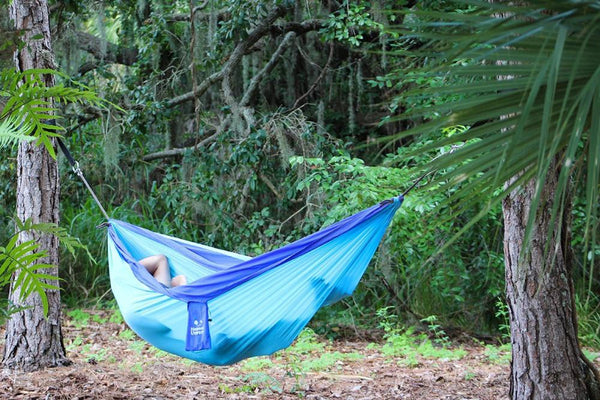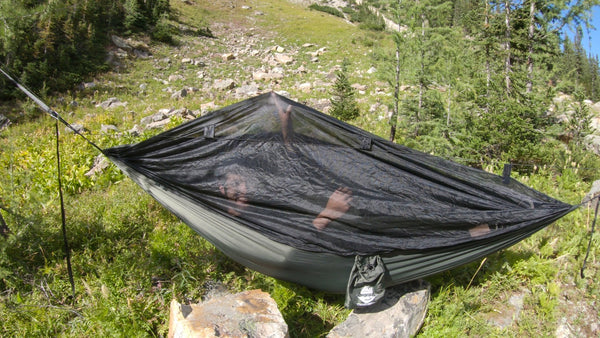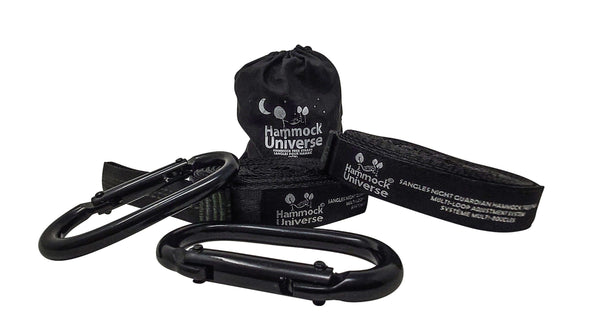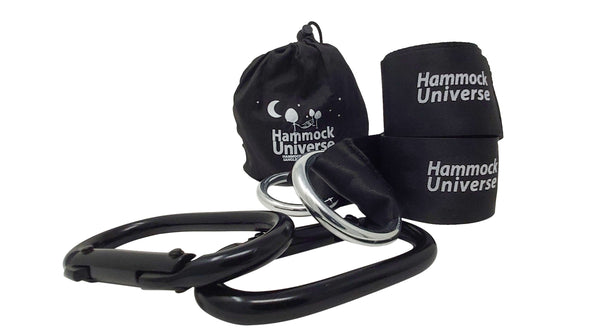FREE SHIPPING on most orders $25+ HAMMOCK BUYING GUIDE
Menu
-
-
Hammocks
-
Hammock Stands
-
Hammocks with Stands
-
Hanging Hammock Chairs
- View all Hammock Chairs
- Brazilian Style Hammock Chairs
- Colombian Hammock Chairs
- Mayan Hammock Chairs
- Mayan Hammock Chairs Deluxe
- Universal Hammock Chair Stand
- U Hammock Chair Stand
- Brazilian Hammock Chair with Universal Chair Stand
- Colombian Hammock Chair with Universal Chair Stand
- Mayan Hammock Chair with Universal Chair Stand
- Mayan Hammock Chair Deluxe with Universal Stand
-
Accessories
- Gift Cards
- Tools and Guides
- Bargain Bin
-
- 1-800-207-4761
- Login

FREE SHIPPING on most orders $25+ HAMMOCK BUYING GUIDE
Hammock Camping in Cold, Rainy Weather? Here’s the Guide to Keep You Warm & Dry
October 05, 2018 6 min read
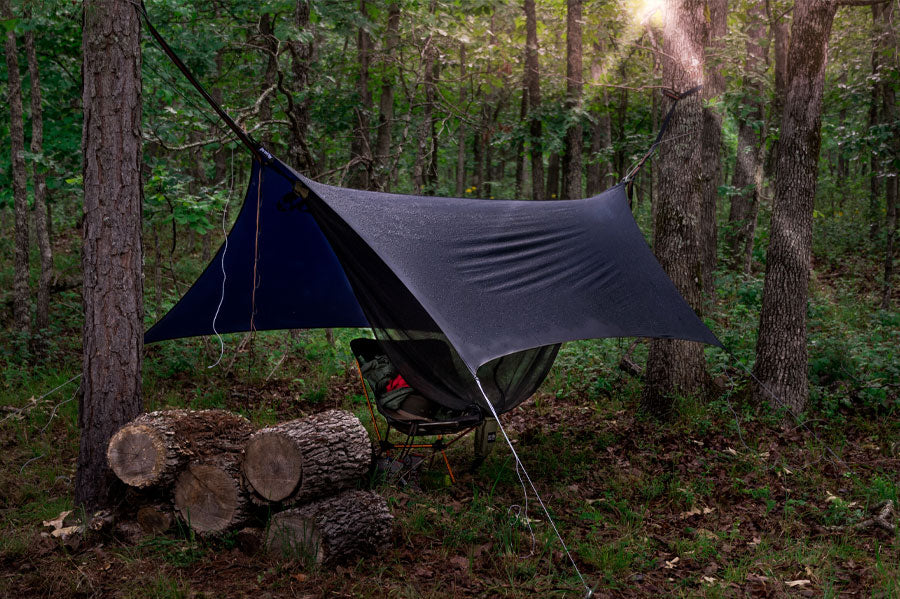
How to Comfortably Go Hammock Camping in the Rain
Fall is an excellent time to go hammock camping not only for the beautiful, calming scenery but because you can enjoy your surroundings with fewer campers around you. When thinking about going camping during the fall season, you’re probably asking yourself, How do you sleep in a hammock in cold weather anyway? And, How do I keep warm in my hammock?
But if you’re an outdoor enthusiast who appreciates the comfort of sleeping in a hammock, any time is a good time for hammock camping.
With the right cold weather hammock camping gear, you can still enjoy your hammock camping trips to the fullest. There are a few things to consider before hitting the trail, but all you need is the right spot to hang your hammock, shelter from the rain, and insulation.
Use our guide and follow these hammock camping tips to ensure you stay warm and dry on cold and rainy days and nights out in the woods.
Preparing for Your Trip
Without a bulky tent to carry with you, you’ll have more room to pack comfortable clothes and gear to keep you warm and dry.
Essential Fall Hammock Camping Items
These are the hammock camping must-haves for fall camping:
- Hammock—you can’t go hammock camping without your favourite camping hammock. If you’re wondering, Are camping hammocks comfortable? The short answer is, yes! And the long answer is: You’ll have a more comfortable night’s sleep in a camping hammock than you will on an air mattress on the ground in a tent.
For hammock camping in wet weather, consider quick-drying nylon camping hammocks with built-in mosquito nets to help keep critters and moisture away. And if you plan to layer up or cuddle up for extra warmth and insulation, you may want a larger double hammock.
- Straps—hammock tree straps are a must to hang your hammock easily from trees without damaging the bark.
- Sleeping bag (or mummy bag)—look for 3-season or winter sleeping bags rated for use in cold weather. Mummy-shaped sleeping bags are the best design for use in a hammock.
- Tarp or rain fly—a waterproof rain fly will keep you warm and dry, sheltering you from the cold wind, rain, snow, and whatever cold elements nature throws your way. Make sure to use a rain fly that works well with your style of hammock.
Nice-to-Haves
To stay comfortable and toasty while hammock camping, also consider bringing these strongly recommended winter hammock camping gear:
- Pillow—a pillow will give your head extra insulation and make your sleep more comfortable;
- Sleeping pads—a hammock sleeping pad gives your body an extra layer of insulation and cushion for a comfortable night’s rest in a hammock;
- Underquilt—an underquilt is one of the best ways to insulate your backside and prevent cold-bottom syndrome while sleeping in a hammock;
- Top quilt—like an unzipped sleeping bag, a top quilt will give you extra warmth on top;
- Sleeping bag pods—these pods are like sleeping bags that go around the hammock while you sleep inside in your own sleeping bag.
Choosing the Right Clothes to Keep You Warm
The clothes you wear while hammock camping in cold, rainy weather will heavily contribute to your overall comfort throughout your trip. It would help if you wore several layers of warm, breathable, and waterproof clothing.
Your clothes should provide enough insulation to keep you warm in the cold temperature while also preventing moisture from lingering on body.
The best way to dress for cold weather is by layering up. Wear a base layer, a middle layer, and an outer layer.
- The base layer—this is the first layer you put on. Since it’s in direct contact with your skin, it should wick away moisture (i.e. sweat) so you don’t freeze. Avoid cotton, and aim for moisture-wicking materials like polyester and spandex.
- The wind layer—this layer is worn on top of your base and protects against the elements like wind and moderate rain. Not always necessary, but it's an extra measure you can take to stay dry.
- The insulation layer—this layer goes on top of the base layer and should be warm for insulation. Microfleece is an excellent material for an insulating layer. You can get microfleece in the form of shirts, pants, and jackets.
- The outer shell layer—this layer is the last layer you put on and is meant to keep the other two layers dry. This layer can be taken off when you go to sleep in your hammock. The outer layer should be waterproof and windproof, like Gortex raincoats and splash pants.
Lastly, warm hats, mitts, gloves, scarves, socks, and boots are a must to keep you warm while hammock camping in cold weather.
What Size Tarp Do I Need for Hammock Camping?
Choosing the perfect hammock tarp can be an easy process. You will need a tarp or rainfly that is large enough to cover your entire hammock, extending 12 inches over each end of your hammock for ultimate coverage. Diamond-shaped rain flies are ideal for keeping you dry in rainy conditions.
But if you plan to go hammock camping in colder, snowier conditions, you may want a larger rectangle, catenary-cut, or four-season tarp with storm doors.
Choosing Your Spot Wisely
You’ll need to find a spot with two healthy, strong trees to hang your hammock. These trees should not have any fruit, ice, snow, or dead or weighed-downed branches that could fall and hurt you.
When hammock camping in cold weather, you should also look for a spot that has a wind barrier, such as a large boulder or a dense forest area.
Tip: Try to avoid camping in areas that are lower than the rest of the land, as cold air will sink and pool in these areas at night.
Top 3 Tips for Pitching the Tarp
In rainy weather, you’re better off pitching your tarp first so you can keep your hammock gear dry while hanging your hammock.
-
Hang the Ridgeline
The tarp ridgeline should be suspended lower on the trees than the hammock suspension. Create a V with the guy lines to provide room for your hammock suspension to fit in between the tarp suspension. -
Set the Guy Lines
Once your tarp is draped over the ridgeline, you can secure it down with guy lines staked to the ground or secured to nearby supports like trees. -
Use Drip Lines
To prevent rainwater from dripping down the suspension lines and soaking you and your hammock, tie the rope that hangs down from the suspension lines. This will direct the rainwater down the rope instead of down into your hammock.
How to Lock in That Heat for Optimal Comfort
Losing body heat while hammock camping in cold weather is not an option. Without proper insulation and clothing, cold air can easily get through the fabrics of your hammock, sleeping bag, and clothing. You'll have a hard time sleeping if this happens.
To avoid freezing, follow these tips to ensure you don’t lose that precious heat and sleep comfortably throughout the night.
Stay Bone Dry
Along with using a rain fly, you can take other steps to stay dry and retain heat while hammock camping.
Damp or wet clothes in colder weather lead to extreme discomfort or freezing. Before climbing into your cozy, dry hammock, make sure your clothes are dry. If not, change them out for a fresh set in your pack.
Tip: Don’t wear too many layers in your hammock, as you’ll likely overheat, sweat, and freeze. Take off your outer layer before climbing in your hammock.
Raise Your Sleeping Bag
A sleeping pad underneath your sleeping bag is a sure way to lock in the heat and keep your backside well-insulated throughout the cold nights.
Foil Blankets
For extra heat, consider hanging a foil emergency blanket above your hammock and under your tarp to reflect your body heat back onto you. Now that’s how you recycle!
Top Quilts and Underquilts
Hammock quilts add the extra layers of insulation you need in cold weather. The colder it gets outside, the more likely you’ll need a top quilt and underquilt to stay toasty in your hammock.
How Cold Is Too Cold to Hammock?
Hammock camping in cold weather is something you should ease into, especially if you’re not an avid camper or if you’re a beginner at hammock camping. If you’ve never done it before, then it’s probably best that you don’t start in the middle of winter when it’s -40˚C with the wind chill.
Instead, go for a night or two in the fall so you can get used to cold-weather hammock camping before braving the frigid temperatures. One of the most important things to realize is that it’s okay (encouraged, even) to turn back if it’s too cold and rainy for you. If you can’t stay warm and dry, it’s not worth your discomfort or the risk of getting sick.
Hammock camping is possible during any season, even when it’s cold and wet. With the right hammock camping gear, you can stay warm, dry, and comfortable while enjoying the crisp air and great outdoors. It’s easy to love your hammock year-round with the right equipment, attitude, and knowledge.
You'll be a hammock camping pro in no time!
Stay warm out there!
Related Products
Want to relax?
Join for exclusive content and promotions we only give to our email list!
